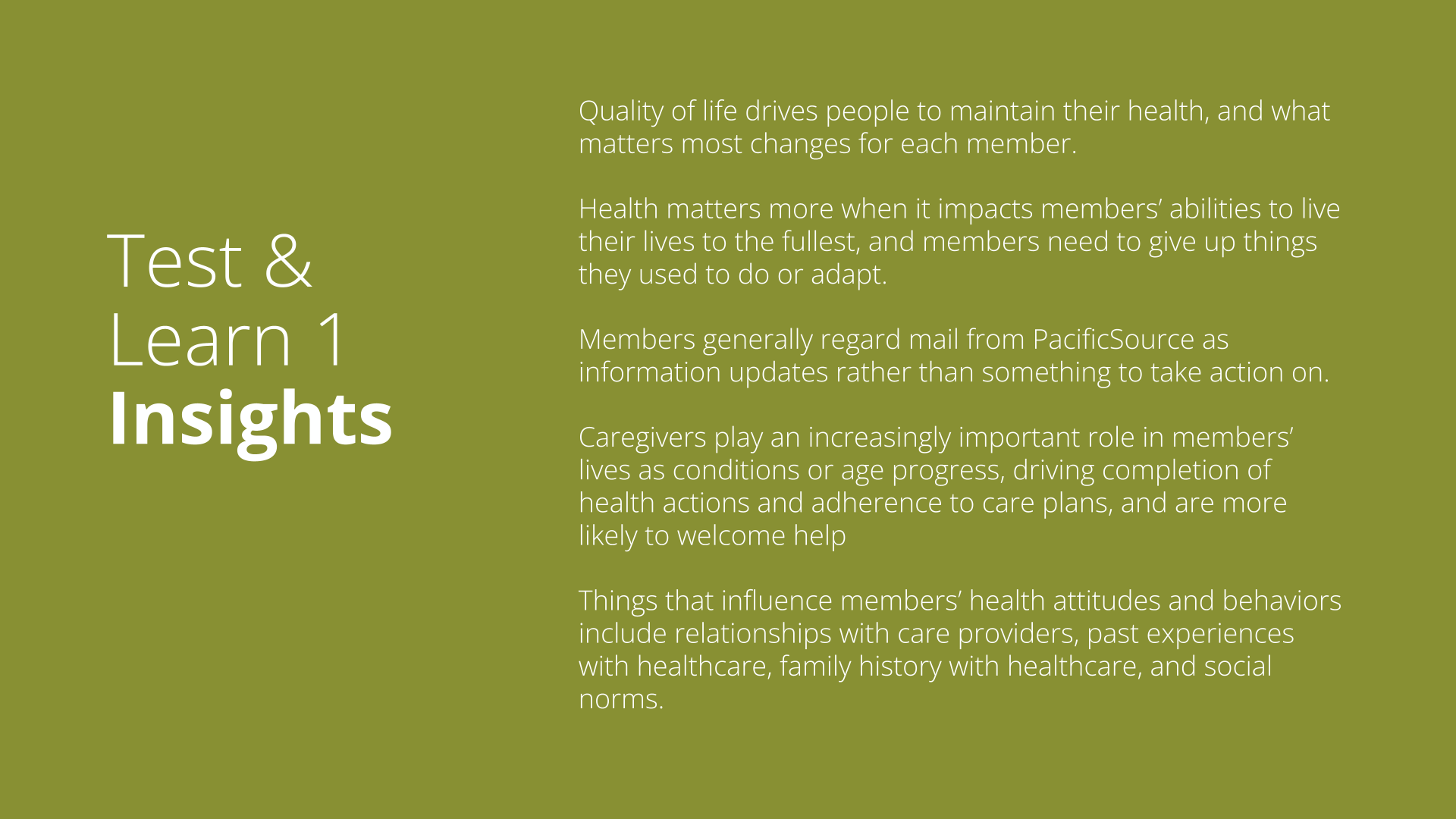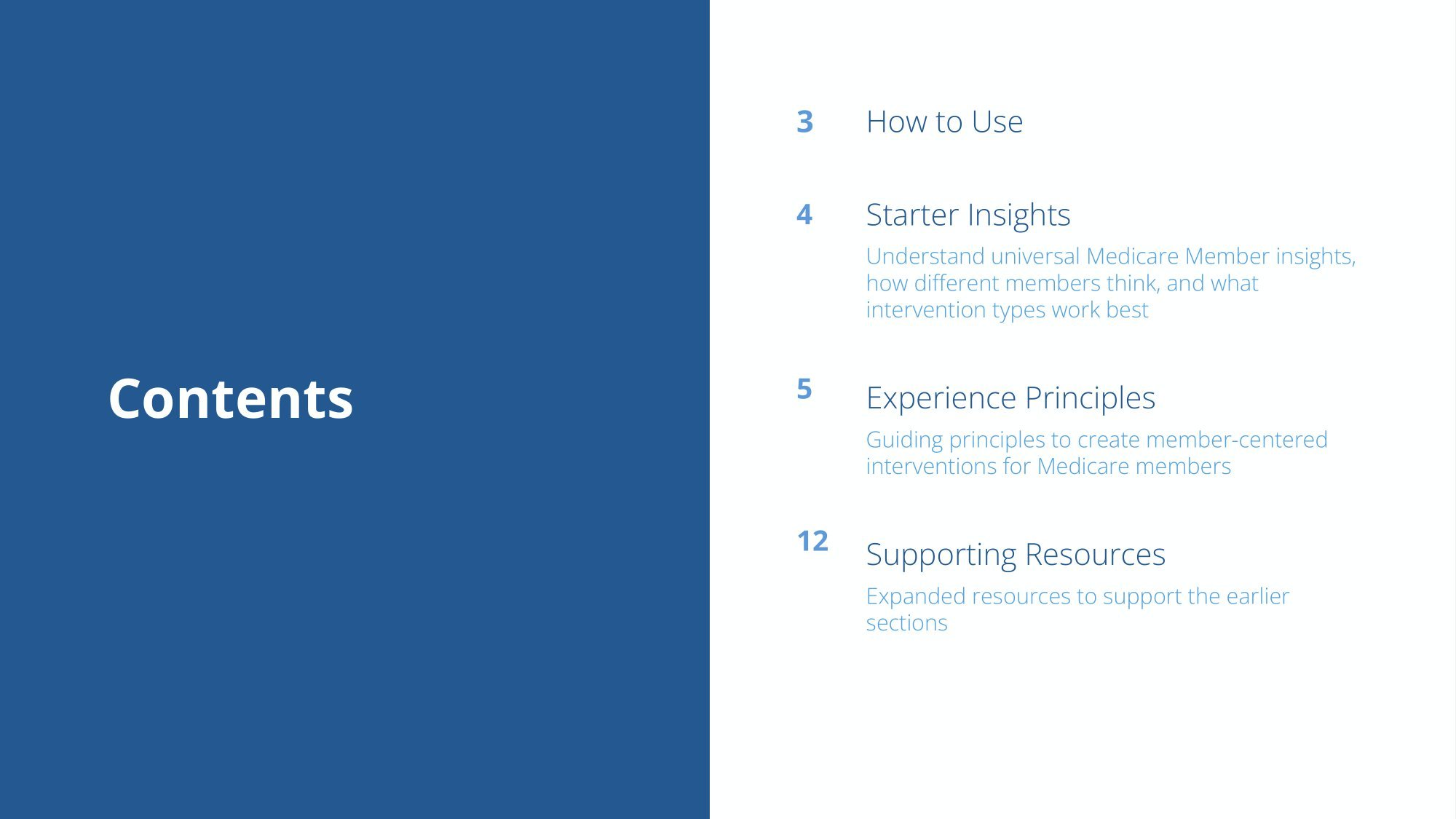PacificSource
Redesigned member engagement and outreach for a non-profit health insurance company.
Lead Designer & Researcher
2020 – 2021 / 8 months
Methods
Service Design
Secondary Research
Qualitative Data Analysis
Individual & Group Interviews
Workshops
Ecosystem & Experience Mapping
Roadmaps
Backcasting
Challenge
PacificSource, a non-profit insurance company based in the Pacific Northwest with 560,000 members, needed to better understand their Medicare members – especially those with multiple chronic conditions – and increase engagement with cost-saving preventative health actions like the Annual Wellness Visit, which also impacted their national ratings.
We needed to identify members' attitudes and behaviors toward health, uncover reasons for low participation in preventative care actions like Annual Wellness Visit (AWV), and address unique barriers for rural members (35% of the member base).
Outcome
We developed a comprehensive toolkit, including revised communication and service approaches for AWV and chronic condition management, starter kits to center insights and design thinking, and a pilot program partnership with a local community health system. Untreated conditions cost PacificSource thousands of dollars per year, so closing these gaps promised to reduce these costs by $2,000-10,000 per member annually.
Role
Project Lead, Designer, and Researcher with one other Designer. I led scoping, project planning, developing research and design activities, and managing client communication and engagement.
Member insights book with all research insights
Research Areas
To motivate members toward completing a specific action (attending an Annual Wellness Visit) and shape long-term behavior change (managing their chronic conditions), we needed to understand more about their unique contexts and motivations. This included:
Their chronic condition journeys and current management systems - or lack thereof
Their care ecosystem, encompassing health professionals, caretakers, and pharmaceutical and technological interventions
Different attitudes and motivations around taking health actions like visiting the doctor, which could vary greatly from condition to condition
Unique barriers for rural members, who made up 35% of the member base
Awareness of and attitudes toward current PacificSource interventions like services and outreach materials
A simple journey map from early research with internal teams and call transcripts
Group interviews with Care Managers and Medicare Support Specialists used a think, then share approach so people had time to reflect, then build on each other’s experiences.
Process
Our process included:
Secondary research to contextualize the healthcare landscape
Analysis of current PacificSource materials and practices
Interviews with members, caretakers, and PacificSource staff
Ecosystem and journey mapping to understand different actors and connections with members, like caretakers and support services
Foresight research with our company’s healthcare technology SMEs to backcast from our clients’ future experience visions for care delivery
Grounded theory analysis using Atlas.ti
Co-design with the client team to explore insights & potential solutions
Concept testing with members
We regularly brought our client team into our research process, using co-creation sessions and workshops to keep them engaged and ensure buy-in across the organization.
Ecosystem mapping for members’ personal healthcare worlds
Leading mini-workshop activities in each biweekly meeting ensured diverse insights and participation
Research
Our clients sought a member-centric approach but wanted to move beyond traditional personas. Their quantitative background led to broad categorizations (e.g., "65+, 2+ chronic conditions") and tactical engagement strategies. We needed to expand their perspective on individual health attitudes and behaviors, challenging assumptions like the notion that rural members were less health-conscious.
To achieve this, we employed directed storytelling, a design ethnography method bringing health experiences to life through personal narratives. We also used Indi Young's Problem Space Research, focusing on individual purposes before considering company solutions. These approaches allowed us to delve deeper into members' thought processes, reactions, and guiding principles around health decisions, providing evergreen insights applicable beyond Annual Wellness Visits.
We presented our findings using member summaries with audio clips and Creative Commons images to avoid posed stock images and bring in specific details mentioned in interviews (like a breed of dog or type of car). This rich, authentic portrayal of members' health journeys fostered a noticeable shift in how our clients perceived and related to members as individuals beyond the categories of conditions and adherence status.
Using more authentic-feeling stock or Creative Commons images and audio
Thinking Styles overview presents a quick reference to compare people’s approaches to health management
Insights
Three key insights stood out as high-level guiding ideas we wanted our client team to keep top of mind.
Members need to feel understood as individuals.
Understand them as people, not just care gaps or risk scores. Get curious about what matters most to each member so you can understand what interventions serve them best instead of overwhelming them with calls and irrelevant service offerings.
Health behaviors can be better understood by Thinking Styles.
Members can switch their thinking styles or mindsets between conditions or intervention types, like taking a hardline stance against medications or attending all screenings except for cancer screenings due to fear. We need to design interventions (services & communications) for various thinking styles to achieve better clinical outcomes across the board.
Member health decisions are driven by what matters to them.
Health itself isn’t the reward or end goal: what matters is what good health makes possible in terms of what matters to them. Quality of life goals and activities, which could be as big as maintaining their mountain bike rides or as small as being able to hold their grandkids on their lap, served as a powerful intrinsic motivator to drive members to maintain their health.
Shaping Behavioral Design with the COM-B Model
We used the COM-B behavior change theory and model to help our clients understand the barriers members faced. Our client typically relied on emails and flyers to remind people, but we learned that information alone wasn’t enough: we needed to address other barriers around attitudes, emotions, and logistics
Thinking Styles: A Flexible Framework for Understanding
We employed Thinking Styles as a framework to understand health decision-making approaches. This framework encompasses:
Inner thinking: Active thought processes and decision-making
Reactions: Emotions or feelings driving actions or decisions
Guiding principles: Foundational rules for decision-making
This approach offers a richer, more flexible alternative to personas by synthesizing behavioral, contextual, and conversational clues. It describes people through flexible attitudes and behaviors, avoiding fixed assumptions from demographics or psychographics, and supporting a broader diversity.
The resulting four mindsets proved more versatile than traditional segmentation based on age or conditions. When combined with the COM-B behavior model, we could effectively map thinking styles to health action barriers and develop targeted interventions.
Pairing Thinking Styles with interventions based on the COM-B model
Thinking Style details including observable signals and COM-B barriers
Reshaping Rural Member Assumptions
Our research challenged prevalent assumptions about rural members, revealing:
Independent Mindset: Rural members often exhibit strong self-reliance, making showing vulnerability or accepting assistance challenging. This "do-it-myself" attitude is deeply rooted in cultural and ideological beliefs.
Cultural Factors: We found widespread distrust of health systems, reluctance to share personal information, and stigma around specific treatments, especially mental health, are common.
Alternative Approaches: While low adherence rates indicated rural members ignored healthcare altogether, we discovered they often turn to non-traditional healthcare practitioners not covered by insurance.
These insights shifted perceptions from stereotypes of disengagement towards a more nuanced view of rural healthcare practices, highlighting the need for tailored, culturally sensitive engagement strategies.
Guiding a New Approach with Member Experience Principles
We developed a set of experience principles for PacificSource based on the insights to keep the new learnings top of mind and help them leverage their organization’s strengths. We worked on these iteratively with them to ensure they felt resonant with and true to the organization and felt actionable enough to use effectively when developing services, products, and communications.
Draft principles with examples in practice
A Detailed Reference: Member Insights Book
We created a detailed insights book to cover our core research questions in-depth and organize additional information that came up throughout the process, like the role of caretakers, so we could extend our research learnings to the full organization.
Sections included member summaries, mini-stories from our members with audio clips from interviews to help bring the concepts to life; reflection questions for teams to apply learnings to their work; and graphic visualizations where possible to make processes and systems more visual. Select slides are included below and the full insights book can be found here.
Concept Testing for New Offerings
Together with the client team, we developed service, product, and communications concepts and ranked them by their level of complexity to inform the roadmap and toolkit and inspire the team with potential ideas.
Bringing Research into Everyday Practice: Insights Starter Kit
We knew teams would need an easy way to bring high-level insights into their daily work with people who hadn’t seen the full research book. We created a Health Action Starter kit, a short 12-page PowerPoint that brought out the most salient insights and experience principles to keep members at the center when developing new services, products, and outreach materials. It could easily fit into existing templates and slide decks, making it seamless for teams to use in any other plan or presentation.
Roadmap & Toolkit to Reach Future Experience Visions
We used our research findings to develop a comprehensive toolkit and roadmap outlining actions that could be taken between 30 to 180 days, as well as thought-starters around other areas we discovered through our research like support for caretakers. Each section provided context, explanations, and resources to support their new way of working and show how pieces connected together.
Impact
We sparked seeds of organizational change at PacificSource to help them focus their efforts on supporting members as individuals and enabled them with the right resources and tools to do so. By looking past classifiers like demographics or risk scores for chronic conditions, our client avoided assumptions and better served their members. We also made plans to present the findings to and train other people at the organization on how to use the resources we created.
We also built excitement for new research efforts and kicked off a new way of working with their local health system partners through a provider partnership pilot workshop we led (details here).
Team
One other Service Designer and part-time Engagement Manager
Summary from our provider pilot partnership workshop.
Roadmap for implementing the provider pilot partnership.
Key Learnings
With free rein to move beyond personas, I leaned into Indi Young’s Problem Space Research methodology to reach a greater depth of understanding. It focuses on listening to people through the lens of their purpose first, rather than in relationship to the product or service your organization wants them to use, and produces evergreen insights that are flexible and durable. I also used behavior change design and referenced the book Engaged: Design for Behavior Change as a key resource throughout the process.




























